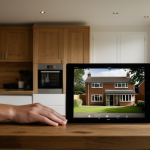Understanding the UK Aesthetic in Interior Design
The UK aesthetic in interior design captures a distinctive blend of classic and contemporary British influences. At its core, British interior design styles combine timeless elegance with a welcoming, lived-in feel. The essence of UK home decor often reflects three key motifs: classic British elegance, modern London chic, and the undeniable charm of the countryside cottage.
Classic British elegance is characterised by sumptuous furnishings, refined symmetry, and rich materials such as mahogany and velvet. In contrast, modern London chic embraces clean lines, urban minimalism, and industrial flourishes, representing the dynamic energy of the capital. The countryside cottage look offers coziness through floral fabrics, natural textures, and vintage accents that evoke heritage and warmth.
This might interest you : How Can You Make a Small UK Home Feel Spacious?
Signature elements in British interior design include layered textures, patterned wallpapers, and traditional prints like tartans and florals. Attention to detail, such as decorative cornices and antique accessories, play a crucial role. Notably, UK home decor stands apart from other European styles by balancing stately grace with quirky, eclectic touches. Compared to American interiors, UK design often emphasizes restraint and subtlety, favouring depth over boldness. This distinctive combination results in spaces that feel both elegant and effortlessly inviting.
Understanding the UK Aesthetic in Interior Design
British interior design style embodies a unique blend of classic British elegance, modern London chic, and rustic countryside charm. This UK aesthetic is distinguished by its ability to balance tradition with contemporary trends, offering both warmth and sophistication. In British interior design styles, you often find rich textures, intricate patterns, and refined materials that create inviting, timeless spaces.
In the same genre : How Can UK Homeowners Reduce Energy Costs Efficiently?
Signature elements define the UK home decor, such as panelled walls, crown mouldings, and a penchant for layering. Cozy fireplaces, vintage textiles, and heritage fabrics like tartans and florals are staples, giving rooms character and depth. The palette often features muted tones or deep jewel colours paired with natural wood finishes, reinforcing the warmth and elegance typical of the style.
Contrasting with American or broader European interior influences, the UK aesthetic favors subtle opulence over flamboyance and prioritizes comfort without sacrificing formality. Unlike the often minimalist Scandinavian style or ultra-modern US trends, British interior design integrates history and personality, making each home feel individual yet cohesive. This distinct combination sets UK home decor apart, offering a well-rounded approach to interior elegance.
Core Principles of UK-Inspired Living Spaces
To fully embrace the classic British design within your home, it is vital to prioritise warmth, comfort, and timeless elegance. The UK home styling ethos revolves around creating spaces that feel inviting and lived-in yet retain a sense of refined sophistication. This balance stems from a deep respect for heritage interiors, where vintage charm meets practical modern living.
Layered textures play a central role in this style. Think of plush velvet cushions on a leather Chesterfield, paired with soft wool throws and heavy patterned rugs. These tactile contrasts contribute to the cosy yet elegant atmosphere characteristic of British homes. Patterns like florals, tartans, and subtle stripes often appear alongside solid colour palettes to provide visual depth.
Blending tradition with modern British accents allows interiors to feel both current and respectful of history. For example, a classic wingback chair might be reupholstered in a contemporary fabric, or antique wooden bookcases can complement industrial light fittings. The key takeaway from classic British design is the harmonious integration of old and new, ensuring comfort and style coexist seamlessly in UK home styling.
Core Principles of UK-Inspired Living Spaces
The classic British design ethos revolves around creating interiors that feel both warm and timeless. Central to these spaces is an emphasis on comfort, achieved through inviting seating and soft textures that welcome relaxation. Heritage interiors often feature a careful blend of tradition and subtle modern touches, ensuring the style feels current without losing its distinguished character.
Layering plays a crucial role in UK home styling, using a mix of fabrics, textures, and patterns to add depth and interest. For example, combining wool throws with velvet cushions over a leather Chesterfield sofa enhances tactile appeal and visual richness. Patterns such as florals or tartans introduce nostalgia while maintaining refined elegance.
The balance between old and new is delicate; traditional panelled walls often coexist with updated lighting or contemporary art, reflecting how British interiors evolve without disconnecting from their roots. This thoughtful combination is what makes classic British design enduring and adaptable, offering spaces that are both visually captivating and deeply comfortable. By prioritising these core principles, UK home styling achieves a seamless fusion of history and modernity.
Choosing Colours and Patterns for a UK Feel
Creating a truly authentic UK aesthetic in your home begins with carefully selecting the right colours and patterns. British interior design styles often lean towards muted tones such as soft greys, warm beiges, and creams, which provide a calm and sophisticated backdrop. These neutrals are frequently paired with rich jewel colours like emerald green, deep navy, and burgundy to add depth and personality, reflecting the classic British elegance found in many UK homes.
When incorporating patterns, traditional prints like florals, tartans, and stripes are quintessential to UK home decor. Florals often appear in upholstery or wallpapers, adding a nostalgic yet timeless quality. Tartan fabrics, with their distinctive plaid pattern, echo British heritage and are commonly used on cushions, throws, or draped over chairs. Stripes provide a subtle contrast and are popular in curtains or bedding, offering structure and rhythm to the space.
Using wallpapers, upholstery, and curtains in these patterns allows you to layer textures and create visual interest—a hallmark of British interior design. Thoughtful combination of colours and motifs can harmonise vintage charm with contemporary comfort, resulting in spaces that are both inviting and unmistakably British.
Choosing Colours and Patterns for a UK Feel
When aiming to capture the UK aesthetic in your interior, selecting the right colours and patterns is fundamental. British colour palettes often feature muted tones, rich jewel colours such as emerald green, sapphire blue, and deep burgundy, alongside neutrals like cream and grey. These shades evoke a sense of elegance and comfort, blending seamlessly within UK home decor.
A cornerstone of British interior design styles is the use of traditional prints. Popular patterns include florals, tartans, and stripes, which contribute layers of texture and historical resonance. For instance, tartan upholstery on a wingback chair can introduce a distinctly British flair, while floral wallpapers or curtains softly enhance a room’s warmth.
Wallpapers and upholstery in these patterns are excellent tools to reinforce classic British elegance without overwhelming the space. Patterned curtains can frame windows with heritage charm, while fabric choices like wool or velvet in these prints add tactile richness.
In summary, combining muted palettes with iconic UK fabric patterns such as florals, tartans, and stripes allows interiors to express a sophisticated, timeless British character. This strategy reflects the depth and subtlety intrinsic to UK home styling, balancing visual interest with warmth and tradition.
Furniture and Accessories that Define a UK Aesthetic
To authentically capture the UK aesthetic in your home, focus on quintessential British furniture styles renowned for their craftsmanship and timeless appeal. Iconic pieces include the leather Chesterfield sofa, with its deep buttoning and sturdy form, offering comfort and stately elegance. Wingback chairs provide classic silhouette and cosy seating, often upholstered in rich fabrics that complement the overall décor. Wooden bookcases and sideboards crafted from mahogany or oak contribute heritage character, grounding the space in tradition.
UK home accessories complete the look by adding nuanced layers of personality and history. Brass accents are particularly popular, found in lighting fixtures or decorative objects, lending a warm metallic gleam typical of classic British interiors. Antique mirrors and ceramic vases further imbue rooms with vintage charm, reinforcing the sense of a lived-in, curated space.
Sourcing authentic and UK-inspired furnishings can involve seeking out specialist retailers or vintage markets both in the UK and internationally. Combining these key furniture pieces and accessories captures the balance of old and new central to UK home decor, ensuring rooms feel rich with story yet perfectly suited for modern living. This approach highlights how furniture and accents are not mere objects but vital expressions of the British interior design style.
Furniture and Accessories that Define a UK Aesthetic
British furniture styles are a cornerstone of the UK aesthetic, with iconic pieces like Chesterfield sofas, wingback chairs, and sturdy wooden bookcases defining traditional interiors. Chesterfields bring classic British elegance through their deep button tufting and rich leather upholstery, adding both comfort and stately appeal. Wingback chairs, often upholstered in tartan or floral fabrics, provide a striking blend of vintage charm and timeless style typical of UK home decor.
Accessories also play a vital role. Brass accents add warmth and a subtle glow, complementing antiques such as ornate mirrors or ceramic vases, which inject personality and historical depth. These items help bridge the gap between heritage interiors and contemporary living spaces, making heritage feel relevant today.
Sourcing authentic and UK-inspired furnishings often requires attention to craftsmanship and provenance. Many British furniture makers specialise in reproducing period styles, ensuring durability and authenticity. Incorporating vintage decor not only enhances visual interest but supports the classic British design ethos of layered, meaningful spaces that feel both lived-in and refined. By carefully choosing furniture and accessories tied to British tradition, one can evoke a genuinely UK aesthetic that celebrates both comfort and history.









